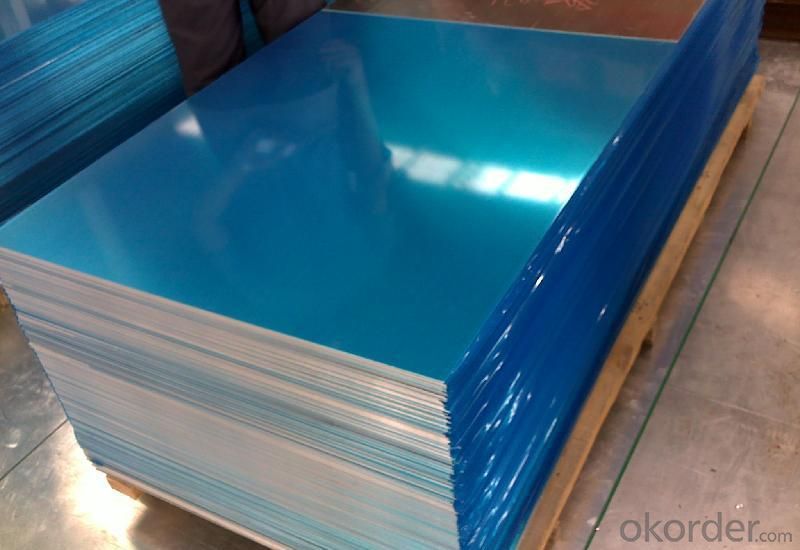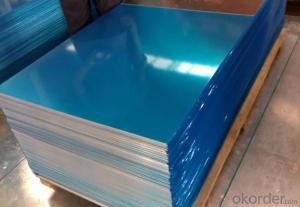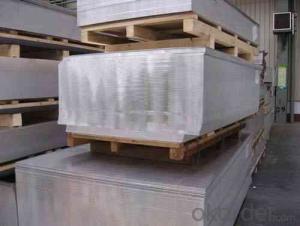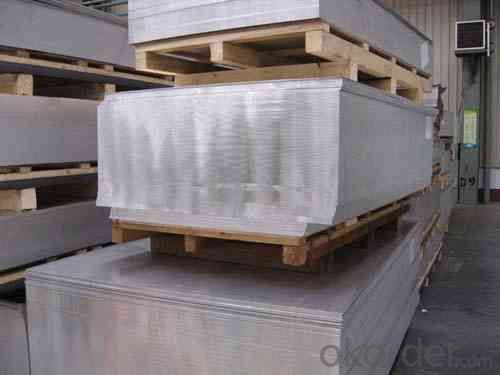Embossed and Plain Aluminum Sheets and Coils
- Loading Port:
- Shanghai
- Payment Terms:
- TT OR LC
- Min Order Qty:
- 5 m.t.
- Supply Capability:
- 9000 m.t./month
OKorder Service Pledge
OKorder Financial Service
You Might Also Like
Item specifice
Specifications
embossed aluminum sheet and coil
1.Alloy:1,3,5,8xxx
2.Thickness:0.3-150mm
3.Width:300-1950mm

aluminum foil | | ||||
Products | Alloy | Temper | Gauge range | Width range | |
Household Foil | 8011 | O | 0.009-0.025mm | 150- 1450mm | |
Container Foil | 8011/3003 | H22/H24/O | 0.03-0.22mm | 150-1450mm | |
Flexible Packaging Foil | 8011/1235 | H22/H24/O | 0.006-0.05mm | 150-1450mm | |
Coated Finstock | 8011/1030B | H14/H22/H24/H26/O | 0.095-0.18mm | 200-1450mm | |
Bare Finstock | 8011/1030B | H14/H22/H24/H26/O | 0.095-0.18mm | 200-1450mm | |
Beer wrap Foil | 8011 | O | 0.01-0.015mm | 200-1450mm | |
Lidding Foil | 8011/8079 | O | 0.03-0.05mm | 200-1450mm | |
Pharma(PTP) | 8011 | H18 | 0.015-0.025mm | 200-1450mm | |
Pharma(SP) | 8011 | O | 0.03-0.09mm | 200-1450mm | |
Heat Exchange Brazing Strip | 3003+4xxx | H14/O | 0.08-0.60mm | 16-1100mm | |
Cable wrap foil | 8011/1145 | O | 0,15-0.20mm | 300-1450 | |
Packing: | well packed suitable for long distance sea transportation. | ||||
Application:Mainly used in food packing, electric capacitor, air-conditioner, cable foil, household foil, food container foil, soft packing foil, refrigerator, medicine and so on.
| |||||
Inner diameter: 75mm, 50mm, 200mm, 220mm, 300mm, 405mm or as your request | |||||
Outer diameter: 100-1500mm | |||||
MOQ: | 5MT per size | ||||
Kind attention:can be customized according the customers request. | |||||
Packaging & Delivery
| Packaging Details: | Wooden pallet packing suitable for export. |
| Delivery Detail: | 20 days after paymnet. |

- Q:What is the weight per square foot of 101 aluminum sheets?
- The weight per square foot of 101 aluminum sheets can vary depending on the thickness of the sheets. Generally, the weight of aluminum is measured in pounds per square foot (lbs/ft²). To determine the exact weight per square foot of 101 aluminum sheets, you would need to know the thickness of each sheet. Once you have the thickness, you can use the density of aluminum, which is approximately 0.098 pounds per cubic inch (lbs/in³), to calculate the weight per square foot.
- Q:Can aluminum sheets be bent without cracking?
- Indeed, aluminum sheets possess the remarkable quality of being bendable without succumbing to cracks. This is due to aluminum's exceptional malleability and ductility, enabling it to be effortlessly molded and reshaped without experiencing fractures. Nevertheless, the success of bending aluminum sheets without cracks hinges upon various factors, including the sheet's thickness, the type and grade of aluminum employed, and the particular bending method employed. To guarantee its integrity and prevent cracks, it is crucial to utilize appropriate tools and techniques when embarking upon the task of bending aluminum.
- Q:Are aluminum sheets suitable for use in HVAC (heating, ventilation, and air conditioning) systems?
- Yes, aluminum sheets are suitable for use in HVAC systems. Aluminum is a popular material choice for HVAC systems due to its various beneficial properties. Firstly, aluminum is lightweight yet strong, making it easy to handle and install in HVAC systems. Its low density also allows for cost-effective transportation and reduces the overall weight of the HVAC units. Secondly, aluminum has excellent corrosion resistance. HVAC systems often encounter moisture and condensation, especially in air conditioning units, and aluminum's resistance to corrosion ensures its durability and longevity in such environments. Additionally, aluminum sheets have good thermal conductivity, allowing for efficient heat transfer throughout the HVAC system. This property is particularly important in heating and cooling applications, as it helps to distribute the desired temperature effectively. Moreover, aluminum is a non-toxic material, making it safe for use in HVAC systems that circulate air throughout buildings. It does not release any harmful particles or gases into the air, ensuring the quality of indoor air. Lastly, aluminum is a highly recyclable material, making it environmentally friendly. The ability to recycle aluminum sheets reduces the carbon footprint associated with HVAC systems and aligns with sustainability goals. Considering all these advantages, aluminum sheets are indeed suitable for use in HVAC systems, providing an optimal balance of strength, corrosion resistance, thermal conductivity, safety, and environmental friendliness.
- Q:How do you ensure the dimensional accuracy of aluminum sheets?
- To achieve the desired dimensional accuracy of aluminum sheets, several actions can be taken: 1. Utilize Advanced Manufacturing Techniques: Employing state-of-the-art equipment and methodologies in the production of aluminum sheets is crucial for ensuring precise dimensions. This entails utilizing reliable and calibrated machinery to accurately cut, roll, and shape the sheets according to the specified requirements. 2. Implement a Comprehensive Quality Control System: Establishing a robust quality control system is essential for upholding dimensional accuracy. This entails conducting regular inspections and measurements at different stages of the manufacturing process to identify any deviations from the required dimensions. Precision measuring instruments, such as calipers, micrometers, or laser scanning devices, can be employed to accomplish this. 3. Opt for High-Quality Materials: The choice of aluminum material significantly impacts dimensional accuracy. Using high-quality aluminum with consistent properties and minimal impurities guarantees that the sheets maintain their desired dimensions throughout the manufacturing process. 4. Control Temperature: Temperature fluctuations can affect the dimensional accuracy of aluminum sheets due to expansion or contraction. Maintaining a controlled temperature environment during manufacturing helps mitigate these effects and ensures that the sheets retain their intended dimensions. 5. Handle and Store Properly: Exercising caution in the handling and storage of aluminum sheets is crucial to prevent any deformations or damages that could impact their dimensions. This involves utilizing appropriate lifting equipment, avoiding excessive bending or twisting, and storing the sheets in a controlled environment to shield them from moisture or extreme temperatures. 6. Regularly Calibrate Measuring Instruments: Regular calibration of measuring instruments used in the dimensional inspection process is vital. This practice ensures accurate measurements and eliminates any potential errors that may arise from instrument drift or wear. By adhering to these measures, manufacturers can minimize dimensional variations and uphold the desired accuracy of aluminum sheets, thereby meeting the specific requirements of various industries such as automotive, aerospace, construction, and electronics.
- Q:What is the maximum temperature resistance of aluminum sheets?
- Aluminum sheets can generally withstand temperatures up to approximately 600 degrees Fahrenheit (315 degrees Celsius), but this may differ due to factors like alloy composition, thickness, and treatment. When contemplating the use of aluminum sheets for high-temperature purposes, it is crucial to refer to the manufacturer's specifications or seek professional guidance.
- Q:I saw some pretty horrific pictures today of bow shooters with their hands impale by pieces of a carbon arrow that broke after being shot. I'm about to get into the archery sport, and I just want to know before I buy my arrows, will it be safer to buy aluminum shaft arrows instead of carbon? People said aluminum ones aren't as strong, but right now I'm more concern with the safety factor. Yes, I do know that I'm suppose to always check carbon arrows for cracks before I shoot them, but we're all human and sometimes people will forget and make mistakes. I just don't want my hand embedded with carbon shrapnel. So should I get carbon or aluminum? Maybe the new full metal jacket ones will be a good compromise?As a side note, my first bow will be a recurve somewhere around the 30-35 lb draw range. Does the power of the bow affect the chances of an arrow breakage?
- In the long run you will find it is much cheaper to use carbon arrows even though the initial cost of them is higher then aluminum. And don't be frightened by the videos of carbon arrows breaking when shooting them. The odds of lightning striking you would be about the same. In most incidences of arrow breakage when being shot, it was with a heavy draw compound and using carbon arrows that were much too light weight to be shot from a bow that they were not designed to be shot from. People sometimes use the lightest weight carbon arrows they can find to make their bow shoot faster then anyone Else's. Sometimes they pay a price for it.
- Q:Can aluminum sheets be easily formed or bent?
- Yes, aluminum sheets can be easily formed or bent. Aluminum is a highly malleable metal, which means it can be easily shaped into various forms without cracking or breaking. This property makes aluminum sheets a popular choice in industries such as automotive, aerospace, and construction, where complex shapes and designs are required. The malleability of aluminum allows for easy manipulation through techniques like rolling, pressing, or bending, enabling the creation of intricate and customized products. Additionally, aluminum's lightweight nature and high strength-to-weight ratio make it an ideal material for forming or bending applications, as it can be shaped without adding excessive weight to the final product.
- Q:What are the different types of alloys used in aluminum sheet?
- There are several different types of alloys used in aluminum sheet, including 3003, 5052, and 6061. Each alloy has different properties and is used for specific applications based on factors such as strength, corrosion resistance, and formability.
- Q:Aluminum siding is essentially maintenence-free, extremelydurable, and is a great insulator, even better than brick. Brickleaks air through the mortar between the bricks, especially in olderhouses that need tuckpointing. My question is, do you feel sidingstill has a declasse connotation, or is it getting more acceptableas the years go on?
- No worse than vinyl. The advantage vinyl has over aluminum is its resistance to denting. Siding is a good finish, but if you've already got a brick exterior, you're wasting the hard hours the masons put in to make it. If the brick has deteriorated or is horribly scarred, like having survived a hurricane or tornado, then sure, siding will spiff it up cosmetically as well as adding insulation value. That said, I'd rather take a house with aluminum siding over wood any day...and vinyl over that. If you get the siding in the color you want, as it's the entire thickness of the vinyl, powerwashing the outside won't take the color off as it could with painted wood or (though less likely) the finish on the aluminum...unless you *like* painting :)
- Q:Are aluminum sheets suitable for furniture manufacturing?
- Yes, aluminum sheets are suitable for furniture manufacturing. Aluminum is a lightweight and versatile material that offers numerous advantages for furniture production. It is corrosion-resistant, making it ideal for both indoor and outdoor furniture. Additionally, aluminum has a high strength-to-weight ratio, allowing for the creation of sturdy and durable furniture pieces. It is also easy to work with, as it can be cut, bent, and welded into various shapes and designs. Moreover, aluminum can be finished with different coatings or paints to enhance its appearance and protect it from wear and tear. Overall, aluminum sheets are a viable option for furniture manufacturing due to their strength, versatility, and aesthetic appeal.
1. Manufacturer Overview |
|
|---|---|
| Location | |
| Year Established | |
| Annual Output Value | |
| Main Markets | |
| Company Certifications | |
2. Manufacturer Certificates |
|
|---|---|
| a) Certification Name | |
| Range | |
| Reference | |
| Validity Period | |
3. Manufacturer Capability |
|
|---|---|
| a)Trade Capacity | |
| Nearest Port | |
| Export Percentage | |
| No.of Employees in Trade Department | |
| Language Spoken: | |
| b)Factory Information | |
| Factory Size: | |
| No. of Production Lines | |
| Contract Manufacturing | |
| Product Price Range | |
Send your message to us
Embossed and Plain Aluminum Sheets and Coils
- Loading Port:
- Shanghai
- Payment Terms:
- TT OR LC
- Min Order Qty:
- 5 m.t.
- Supply Capability:
- 9000 m.t./month
OKorder Service Pledge
OKorder Financial Service
Similar products
New products
Hot products
Related keywords































